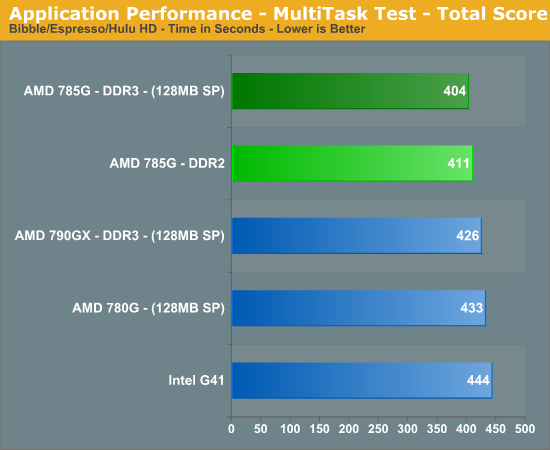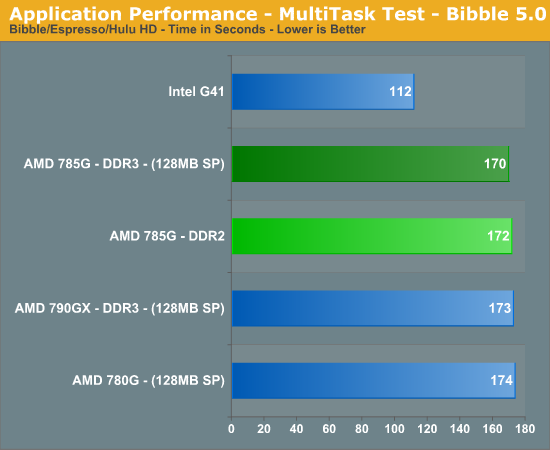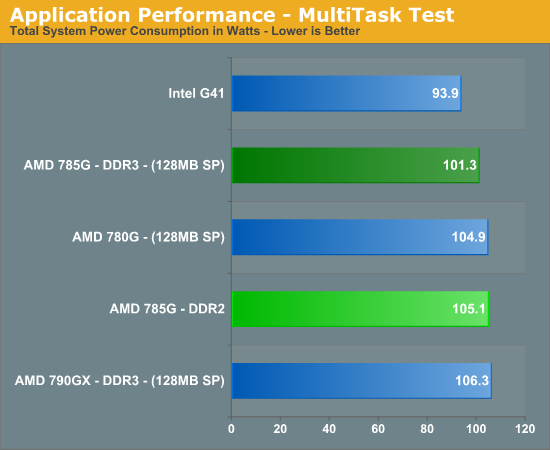AMD's 785G Chipset - Revolutionary or Evolutionary?
by Gary Key on August 4, 2009 5:00 AM EST- Posted in
- Motherboards
Heavy Multitasking: Our typical workday at home.
The vast majority of our benchmarks are single task events that utilize anywhere from 23MB up to 1.4GB of memory space during the course of the benchmark. Obviously, this is not enough to fully stress test our 4GB memory configuration. We devised a benchmark that would simulate a typical home situation and consume as much memory without crashing the machine.
We start by opening two instances of Internet Explorer 8.0 each with six tabs opened to flash intensive websites followed by Adobe Reader 9.1 with a rather large PDF document open, and a nice game of video poker banished to the taskbar. We then open Bibble 5 with our standard test setup, and CyberLink Espresso with the YouTube HD conversion file, Microsoft Excel and Word 2007 with large documents, Hulu TV, and finally Photoshop CS4 with our test image.
We wait two minutes for all activities to cease and then start playing Legend of the Seeker via Hulu HD TV at 1280x720, start the photo conversion in Bibble, and then the HD transcode in Espresso. Our maximum memory usage during the benchmark is 3.37GB with 100% CPU utilization across the two threads.



Thanks to the hardware decoding offload in Espresso, our AMD 785G DDR3 platform finishes our two tasks 40 seconds before the Intel G41 configuration or for our percentage trackers, AMD is over 9% quicker. Looking at the individual scores, the Intel system walks away in the Bibble test but falls short in the Espresso application.
We did experience a few stutters with the Intel G41 system during heavy action sequences in our HD video feed that were not present on the 785G even though our Espresso test sequence was off loaded to the GPU. Throughout all of our testing, it was this one test that impressed us the most with the 785G platform, especially its video playback capabilities.

While the Intel platform was 9% slower, it also consumed almost 8% less energy.










43 Comments
View All Comments
Hrel - Saturday, August 22, 2009 - link
You showed Nvidia stats on the first page... I guess you didn't include them cause ATI and Intel can't even compare???Next time include the Nvidia results... would've thought that it'd an impulsory action; guess not.
crochat - Tuesday, August 18, 2009 - link
Gary,You mentioned a motherboard roundup in your conclusion. I thought it would come sooner.
Regards
AlB80 - Sunday, August 16, 2009 - link
1. The A-Link Express II is a proprietary interface developed by AMD basing on the PCI Express Gen2 version 2.0 technology, with additional Northbridge-Southbridge messaging functionalities.2. High data transfer bandwidth (up to 2.5 Gb/s / Lane)
Concillian - Saturday, August 15, 2009 - link
"Remember when ATI made crappy chipsets that no one bought, and all AMD systems were built with NVIDIA or even VIA chipsets? "Yeah, I remember that, thats when they were really AMD chipsets and not ATi chipsets with an AMD label on them. ATi started making good Crossfire chipsets shortly before AMD bought them.
I like AMD as much as the next guy, but let's not be patting them on the back too hard. They tried, failed, then did what any good American businessman would do... bought a struggling competitor to use their IP.
IntelUser2000 - Saturday, August 8, 2009 - link
Gary, you got the clock speed of the G41 IGP wrong:http://www.techarp.com/showarticle.aspx?artno=543&...">http://www.techarp.com/showarticle.aspx?artno=543&...
G41 and G43 uses a 667MHz core while G45 uses 800MHz.
Notice the differences here: http://global.hkepc.com/1525/page/3#view">http://global.hkepc.com/1525/page/3#view
ClagMaster - Saturday, August 8, 2009 - link
The 785G is just a 780G which has recieved a fine tuning. Which is OK. There are slight improvements in performance over the 780G but nothing to be excited about. 785G Seems to work well with DDR3 memory and Athlon II processors.I have an ASUS M3A78EM 780G Mobo with an AMD BE2400 X2 CPU I use as a secondary computer I keep off-line for private matters. It's a fairly powerful rig for the media applications I run.
The HD 3200 GPU is just as powerful as a Geforce 4200 graphics card. I can play DX8 and DX9 games from the 2002-2004 period (Max Payne, Aquanox, Homeworld2) with acceptable framerates at 1280 x 1024 resolution. I run Windows XP Home.
The 785G is not bad. But if I had a choice between a 785G mobo and a 780G mobo with the 780G costing $5-$10 less, I would buy the 780G mobo. I can still run Windows 7 with the 780G with the HD3200.
ClagMaster - Saturday, August 8, 2009 - link
BTW-This article was not boring. It honestly compared the performance capabilities of the 785G to other chipsets of its class (780G and G41).
Most differences between the 785G and 780G were small and within the combined statistical uncertainty of the benchmark measurements measurements +/-10% (i.e. statistically insignificant). Not very surprising. Most of the larger differences observed were between systems with DDR2-1066 and DDR3-1333 memory systems.
I agree the 785G is a better balanced chipset than the 780G and G41 for multimedia.
I wish Gary would have used an older benchmarking suite so I can compare the performance between current and systems 2-3 years old. I prefer PCMark2005 and 3DMark2005 since these are reliable indicators of performance. This is important to me because I try to make my purchasing decisions on the criteria of having double the performance for the same cost and power consumption.
ClagMaster - Saturday, August 8, 2009 - link
BTW-This article was not boring. It honestly compared the performance capabilities of the 785G to other chipsets of its class (780G and G41).
Most differences between the 785G and 780G were small and within the combined statistical uncertainty of the benchmark measurements measurements +/-10% (i.e. statistically insignificant). Not very surprising. Most of the larger differences observed were between systems with DDR2-1066 and DDR3-1333 memory systems.
I agree the 785G is a better balanced chipset than the 780G and G41 for multimedia.
I wish Gary would have used an older benchmarking suite so I can compare the performance between current and systems 2-3 years old. I prefer PCMark2005 and 3DMark2005 since these are reliable indicators of performance. This is important to me because I try to make my purchasing decisions on the criteria of having double the performance for the same cost and power consumption.
7Enigma - Thursday, August 6, 2009 - link
Gary,Thanks for the article but could you keep in mind for future articles on non-gaming hardware (i.e. IG's, budget GPU's, etc.) to make sure the game description is in line with the actual article? I can tell they were just copied directly from a previous gaming article, so it's a bit silly to see, "We crank up all the details to max", only to see the data chart show 1024X768 with low settings.
:)
AlB80 - Wednesday, August 5, 2009 - link
DMI 10Gb/s each direction, full duplexaka
4 lane PCIe 1.1